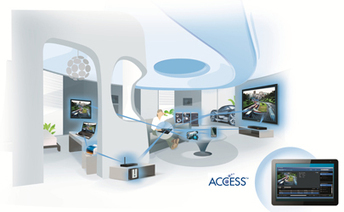ACCESS has been presenting a vision of how Pay TV operators can start to marry their broadcast/VOD infrastructure with multiscreen/OTT delivery infrastructure and treat them as a shared resource to optimize the delivery of content to multiple devices around the home, including televisions. It uses its Netfront Living Connect DLNA stack and client software to provide a central view of what each device is capable of and what is currently happening on that device to then manage whole-home resources.
Content can be distributed using the new DLNA Commercial Video Profile-2 (CVP-2), which was developed with the cooperation of service providers to enable more secure playback of their content across multiscreen devices. It also gives them more control over the user interface on different devices. CVP-2 leverages HTML5 Remote User Interfaces (RUIs) and HTTP Adaptive Delivery and Authentication on top of the DTCP-IP-based link layer protection, which was already available. ACCESS is actually demonstrating NetFront Living Connect with CVP-2 at the DLNA Members meeting in Hawaii today (Thursday October 10).
In this new architecture, DLNA acts as an abstraction layer. Not only does it provide a unified view of activity across diverse devices, it also means platform operators can avoid writing native apps for each DLNA-enabled device. You still need a software client to reach them but not the unique applications development work. “DLNA is a way to overcome device fragmentation,” says Larbey at Alcatel-Lucent.



 Your new post is loading...
Your new post is loading...















